Polignano a Mare - in the blue painted blue
Think of Puglia and you may well picture Polignano a Mare. It has one of the most iconic views of Puglia, often found on the cover of guide books to our region. The town’s most iconic beach, Lama Monachile, is nestled between two dramatic cliffs, with crystal-clear waters lapping against a small pebble shore. This inlet, historically used as a port, is now one of the most photographed spots in Puglia. Oh, and that song you know, “Volare”...
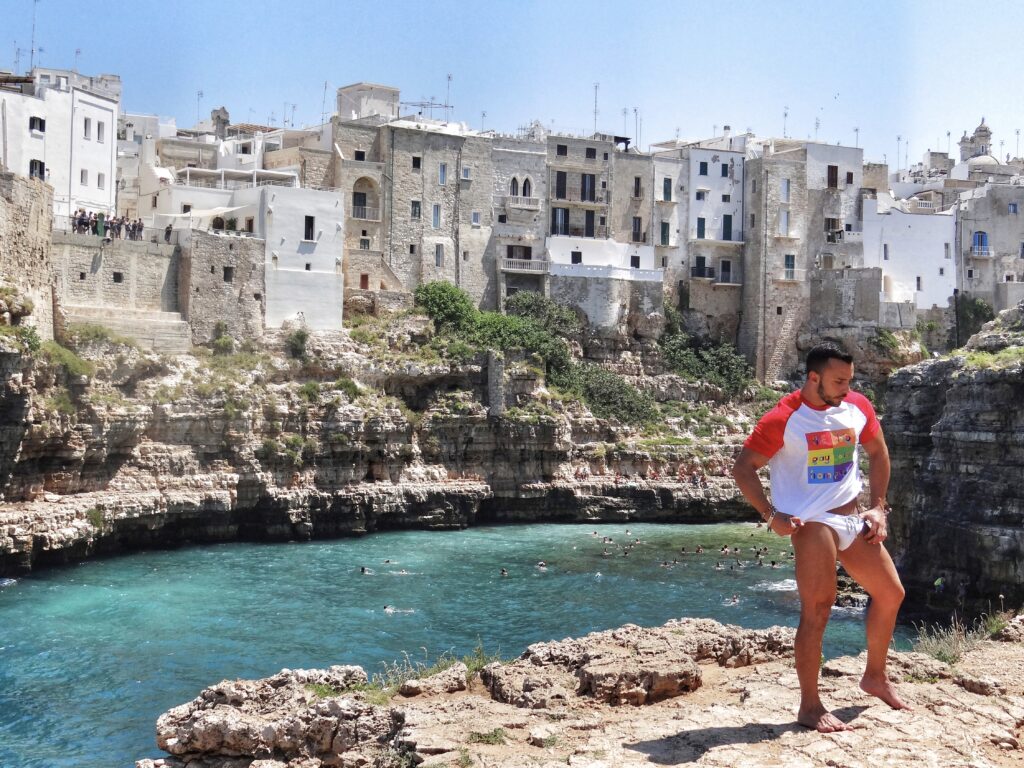
Nel blu, dipinto di blu
Polignano a Mare. Where the blue meets the blue. One of Puglia’s most famous beaches, but with only pebbles and stones underfoot, not the most comfortable. Quite small, its particularly crowded at the height of summer. Rocky and rapidly deep, nothing beats the experience of swimming out beyond the cliffs that contain the bay. Watch the children and teenagers - and the brave - jump and dive off them all day long.
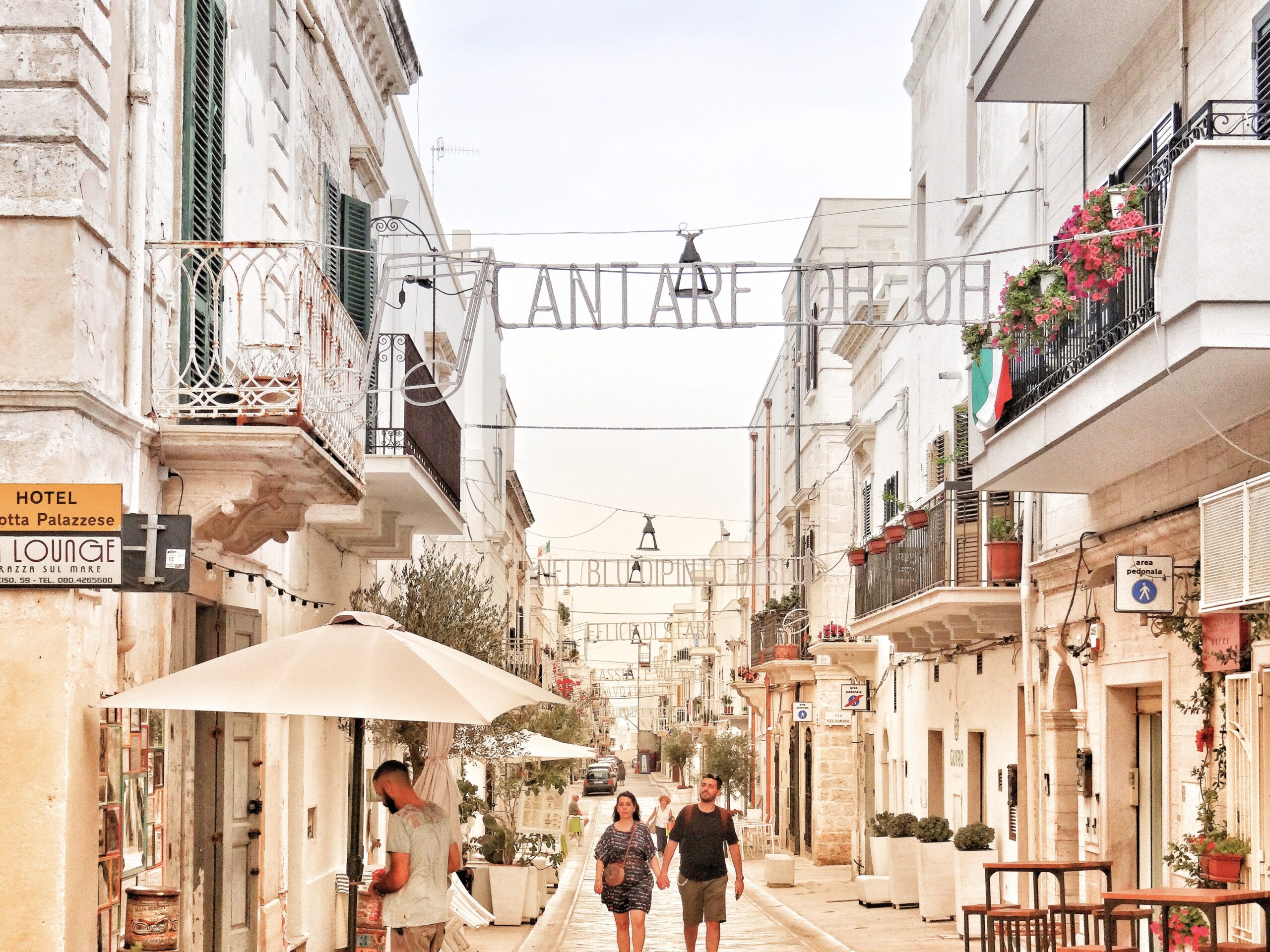
Volare, Oh-oh
Cantare, wo-oh, oh-ho. Polignano’s most famous son is Domenico Modugno, co-writer and singer of Nel blu, dipinto di blu - better known as Volare. Frozen forever in time in his famous Volare pose, his statue takes pride of place above the Modugno steps that lead down to spiaggia Domenico Modugno (where you get one of the best views of the old town). The lyrics feature as Christmas lights that still run down the length of Via Roma.
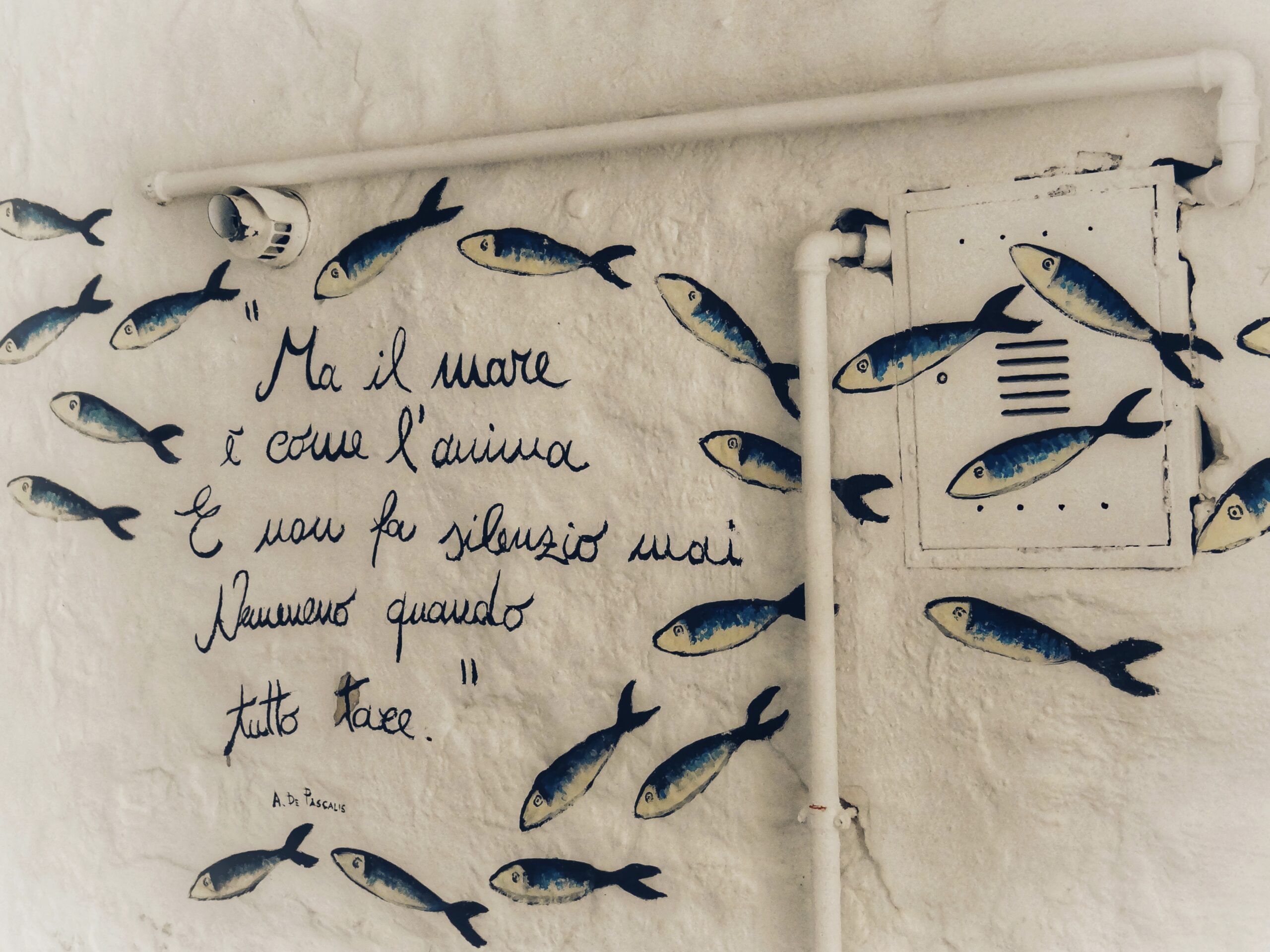
Follow the poetry
Guido il Flâneur is the poet who started writing and drawing poetry and verse on the walls and doors of the streets of the old town, but his is not the only work on display.
The Big Guide to Polignano a Mare
An imposing old town sits atop a 20-metre limestone cliff overlooking the azure waters of the Adriatic. Lama Monachile beach offers one of Puglia’s most iconic views. Wondering around the old town’s knot of winding streets will lead you to one of three Balconata sul Mare. Panoramic terraces with wonderful views of the rocky coastline rising out of the deep blue sea that bleeds into deep blue sky.
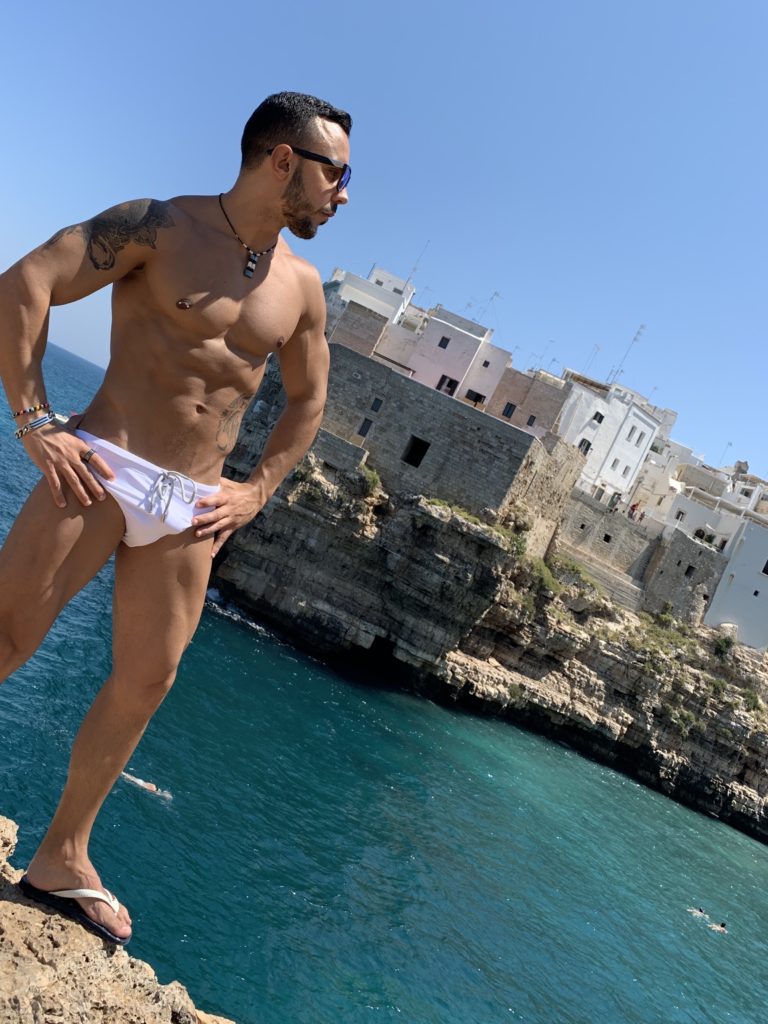
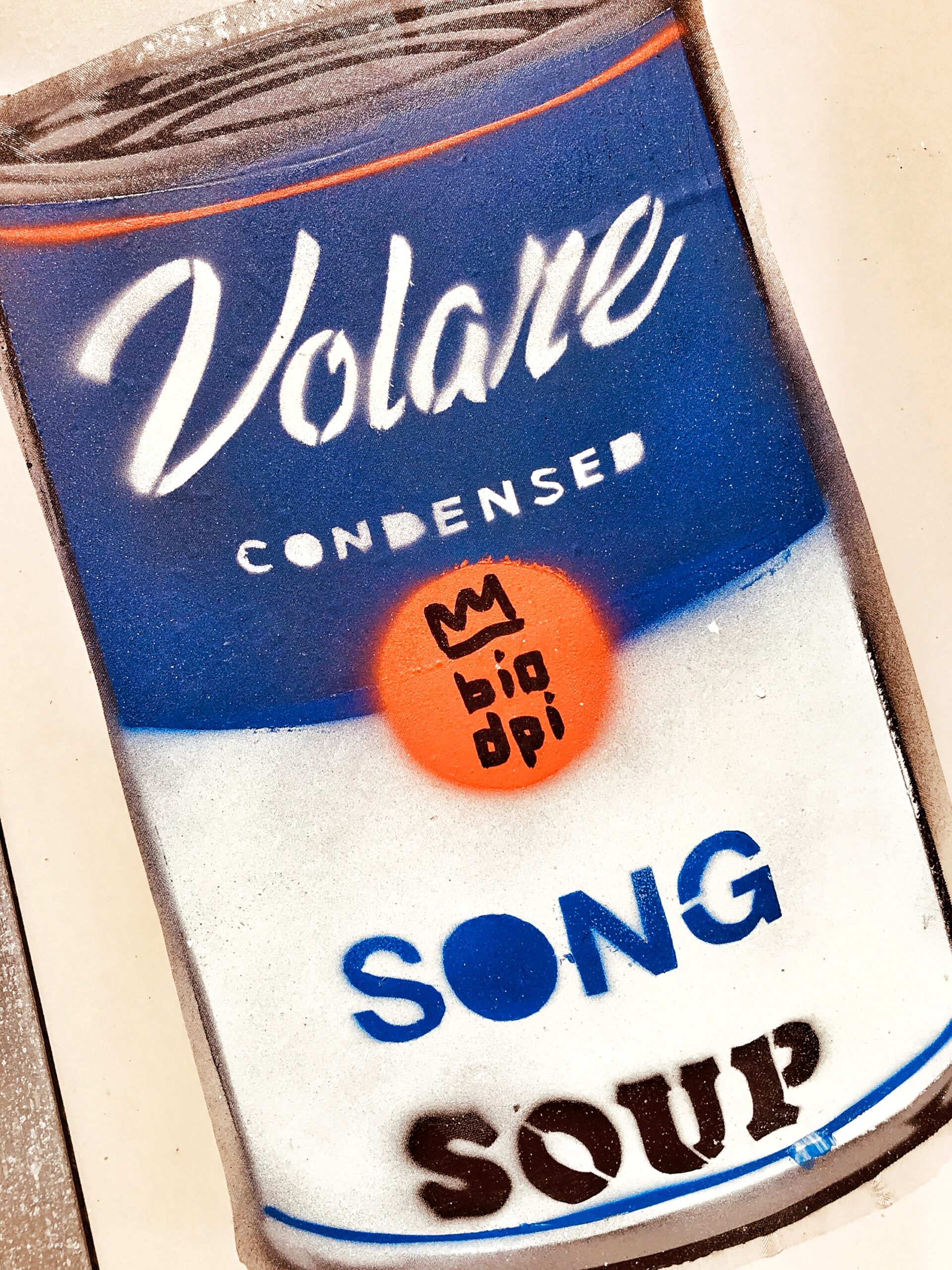
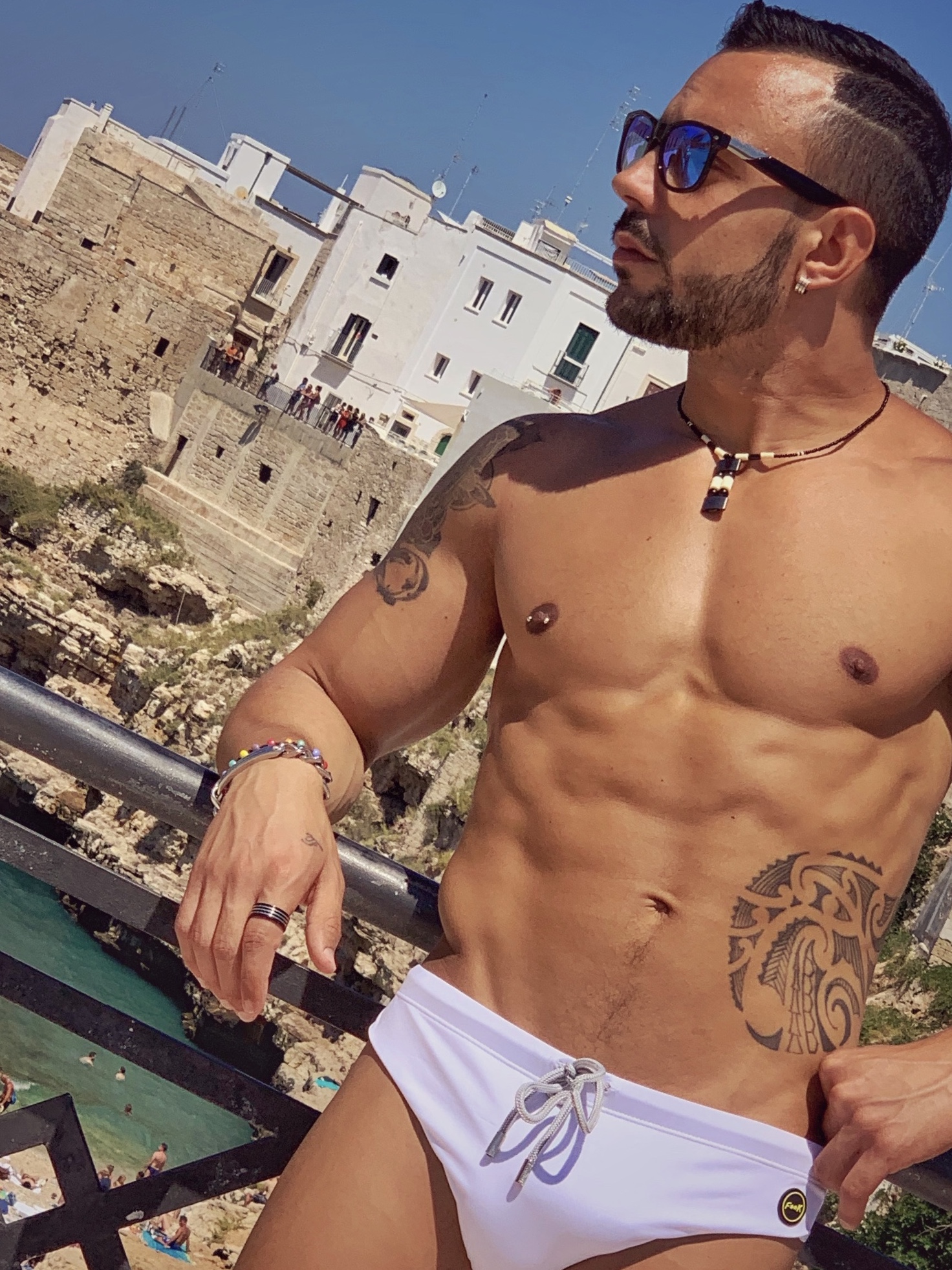
The Basics
No trip to Puglia would be complete without visiting Polignano a Mare. Its popularity and iconic status mean that Polignano is one of the more expensive destinations to stay in by Puglia standards. But it’s easily accessible by public transport - trains run regularly between Bari and Brindisi and onward to Lecce.
The small but perfectly formed centro storico can be reached through the Porta Vecchia gate. Its winding white-washed streets make exploring an adventure. More so if you follow the poetry.
The streets, walls and doors of Polignano’s old town are decorated with poetry drawn by Guido Lupore, using the tag Guido il Flâneur. His work first appeared in 1992 in the piazzo Santo Stefano, which he dedicated to dolphins. Some of the verses are his, though he more often uses the poetry and words of other writers.
One of his best known works are seen on the Vicolo della Poesia - the poetry steps. Find them on your way through the old town.
With superb seafood (the town’s name - a Mare - gives it away), cool bars (try La Casa del Mojito | Via Annunziata, 19) and chic boutiques - and that view - Polignano a Mare has much to offer.
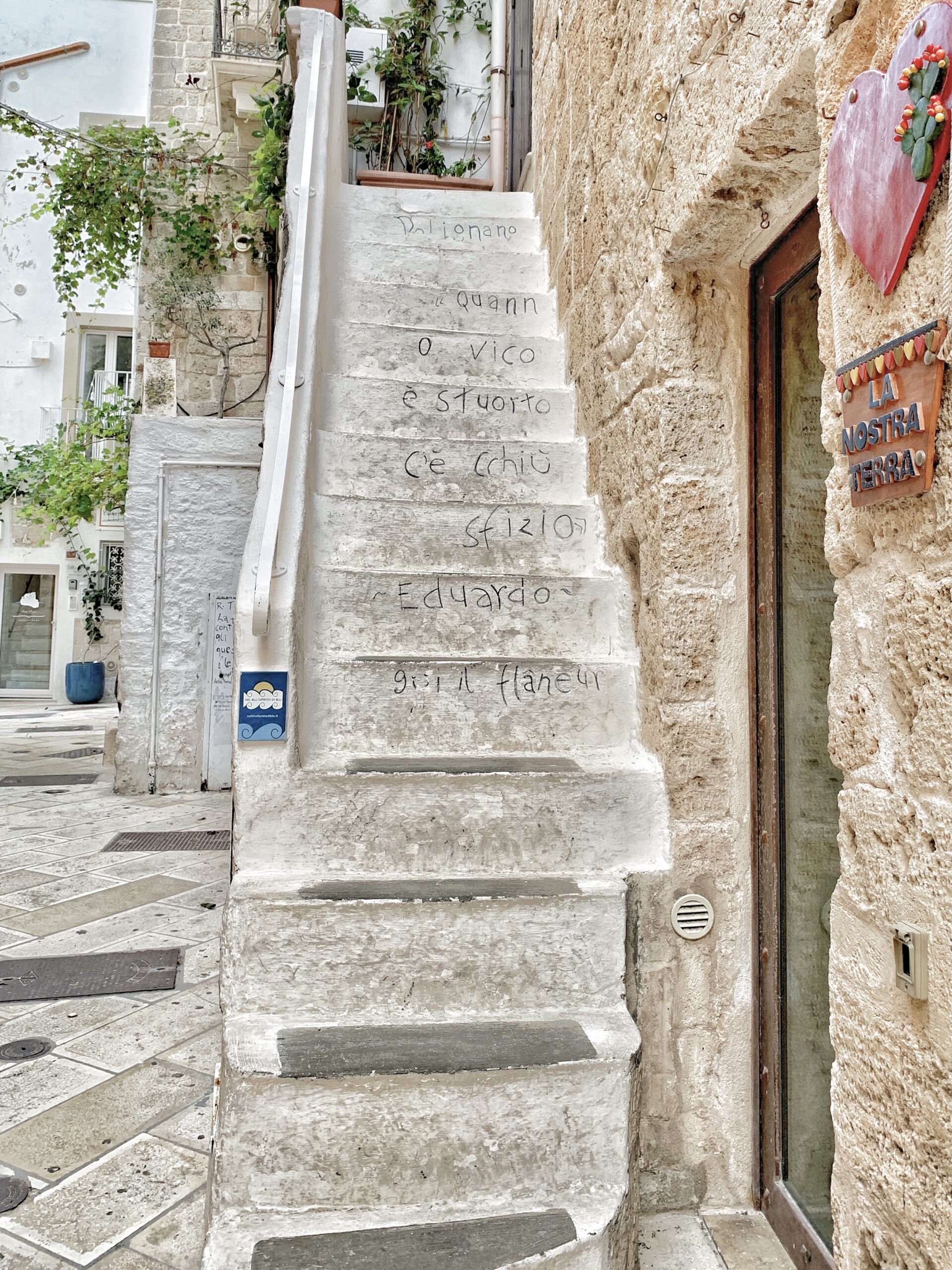
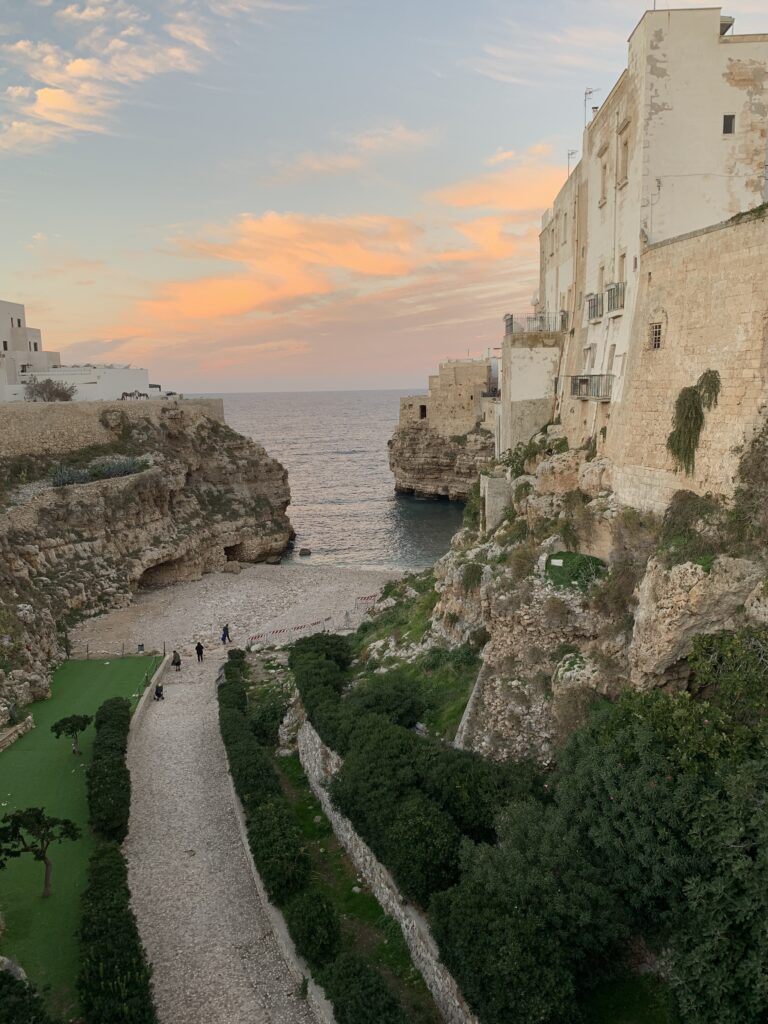
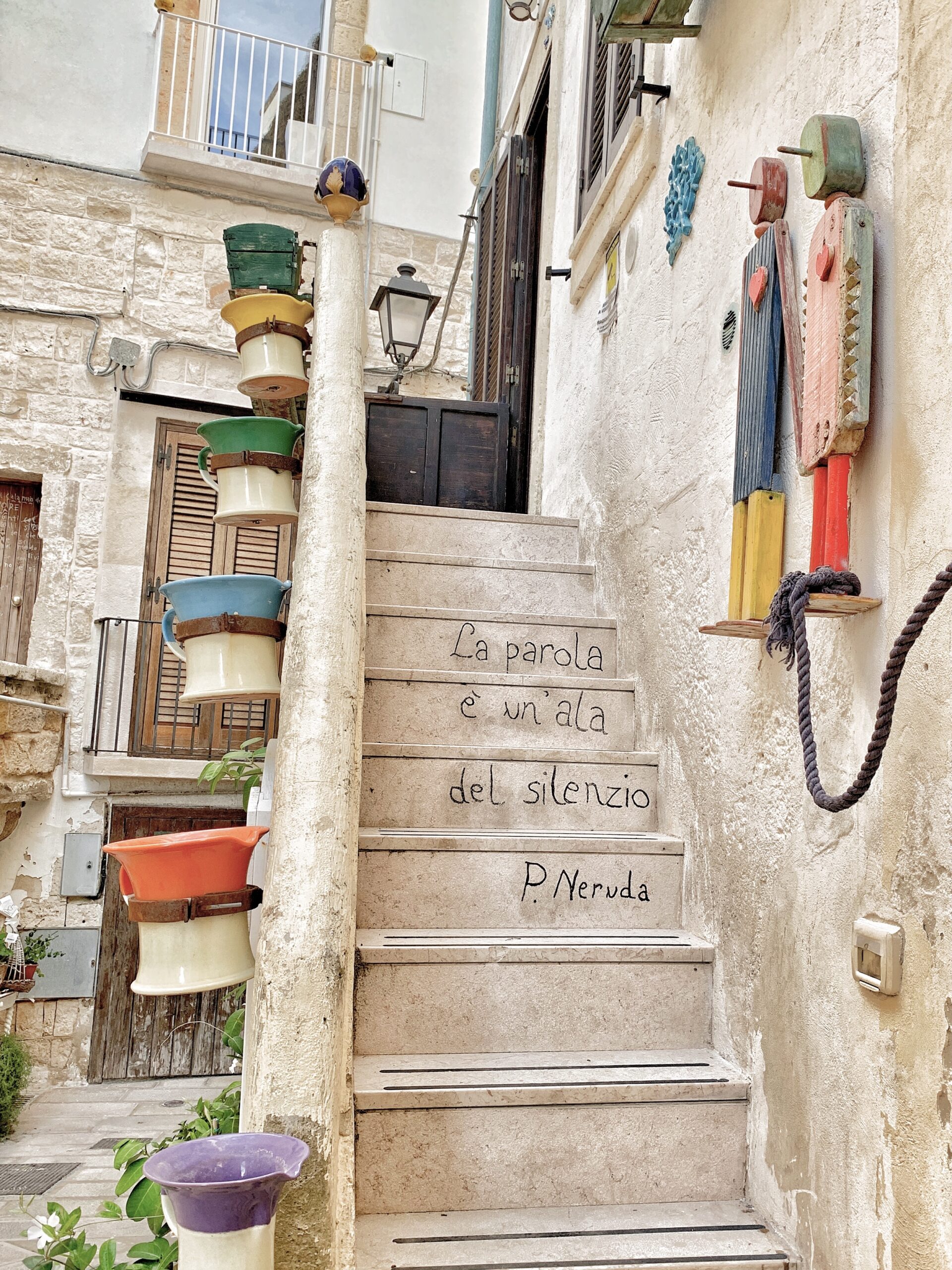
A History Carved in Stone
According to ancient legend Polignano a Mare stands on a piece of the Greek coast that drifted across the Adriatic.
Polignano’s history dates back to prehistoric times, with evidence of human settlement found in several caves, including Grotta dei Colombi, Grotta del Guardiano, and Grotta dei Ladroni. These caves have revealed Palaeolithic and Neolithic artefacts, confirming the area’s significance long before recorded history.
Believed to have been founded around the fourth century BC, by Dionysius the 2nd, tyrant of Syracuse for its strategic location to control of the shipping trade.
During the Roman era, Polignano was a minor settlement along the Via Traiana, the ancient road connecting Benevento to Brindisi. While it did not rise to great prominence, remnants of its Roman past can still be seen, including the Roman bridge near Lama Monachile, which was once part of the Trajan Way built in 109 AD as an extension of the Via Appia, connecting Rome to Brindisi.
After the fall of the Roman Empire, Polignano was influenced by various rulers, including the Byzantines, Normans, Angevins, Aragonese, and Bourbons. In the 11th century, it became a Norman county, later transitioning into a marquisate under the Kingdom of Naples. Throughout these periods, the town’s fortifications were strengthened, and its medieval layout took shape.
The Historic Centre
Polignano’s historic centre is a maze of narrow, winding alleys, whitewashed houses, and small balconies overlooking the sea. This quarter is enclosed by remnants of the medieval walls, once reinforced by four towers. The entrance to the old town is marked by the Arco della Porta (also known as the “Arco di Gesù”), which leads into Piazza Vittorio Emanuele II, the heart of the city.
One of the square’s most intriguing features is its 19th-century public clock, one of the few surviving examples that is still manually wound by pulling ropes. Nearby stands the 16th-century Parish House, a structure supported by seven elegant arches.
Among the most significant landmarks in the old town is the Chiesa Matrice (Mother Church), originally built in 1295 and dedicated to Santa Maria Assunta. The church, which blends Renaissance and Baroque architecture, houses numerous artistic treasures, including:
- A 16th-century inlaid wooden pulpit
- A 1776 baptismal font with an intricate polychrome marble pyramid
- A large wooden choir from 1661, restored in 1773
- A polyptych by Bartolomeo Vivarini, a celebrated Venetian painter
- A 16th-century nativity scene sculpted from “carparo” tuff by Stefano da Putignano
Other religious sites include the Chiesa del Purgatorio, featuring an ornate Baroque façade, and the former Church of San Stefano, now transformed into an art gallery showcasing contemporary works.
The Expansion of Polignano
While the historic centre retains its medieval character, Polignano’s modern district began to develop in 1786, when King Ferdinand IV of Bourbon approved the expansion of the town. Today, the modern quarter extends inland and along the coastal routes towards Monopoli and Mola di Bari, reflecting the town’s growth beyond its medieval walls.
Polignano’s economy is driven by tourism, fishing, agriculture, and trade, with local restaurants offering fresh seafood dishes and traditional Puglian cuisine, including orecchiette pasta, burrata cheese, and focaccia Barese.
A Journey Beyond the Town
The coastline is riddled with erosion-carved caves, the most famous of which is Grotta Palazzese. This spectacular sea cave has been transformed into a seasonal restaurant, allowing visitors to dine in a breathtaking cavern with uninterrupted views of the turquoise waters. But a word of warning. The view may have impressed us, but the food certainly did not.
Many of these caves—Grotta di Ardito, Grotta delle Rondini, Grotta dei Colombi, and Grotta delle Monache—can only be accessed by boat, making a boat tour an unmissable experience for visitors.
Just three kilometres from Polignano lies the Abbey of San Vito, a former Benedictine monasterybuilt on a narrow peninsula believed to be the site of the ancient Roman settlement of Apenestae. The abbey, once part of a strict monastic community, still showcases its Romanesque architecture, with a three-domed nave and a crumbling watchtower at the tip of the peninsula.
Visitors can:
- Explore the medieval alleys and admire the town’s ancient architecture
- Swim in the crystal-clear waters of Lama Monachile and discover hidden sea caves
- Dine in the world-famous Grotta Palazzese, an unforgettable experience in a natural cave
- Take a boat tour to explore Polignano’s dramatic coastline and marine grottos
- Discover centuries of art and history in the Chiesa Matrice and historic squares
- Visit the Abbey of San Vito, a stunning blend of history and coastal beauty
Polignano’s charm has captivated artists, poets, and musicians, including Domenico Modugno, the singer of the classic Italian song “Volare”, who was born here. A statue of Modugno stands proudly near the waterfront, where visitors can enjoy spectacular sunset views over the Adriatic.
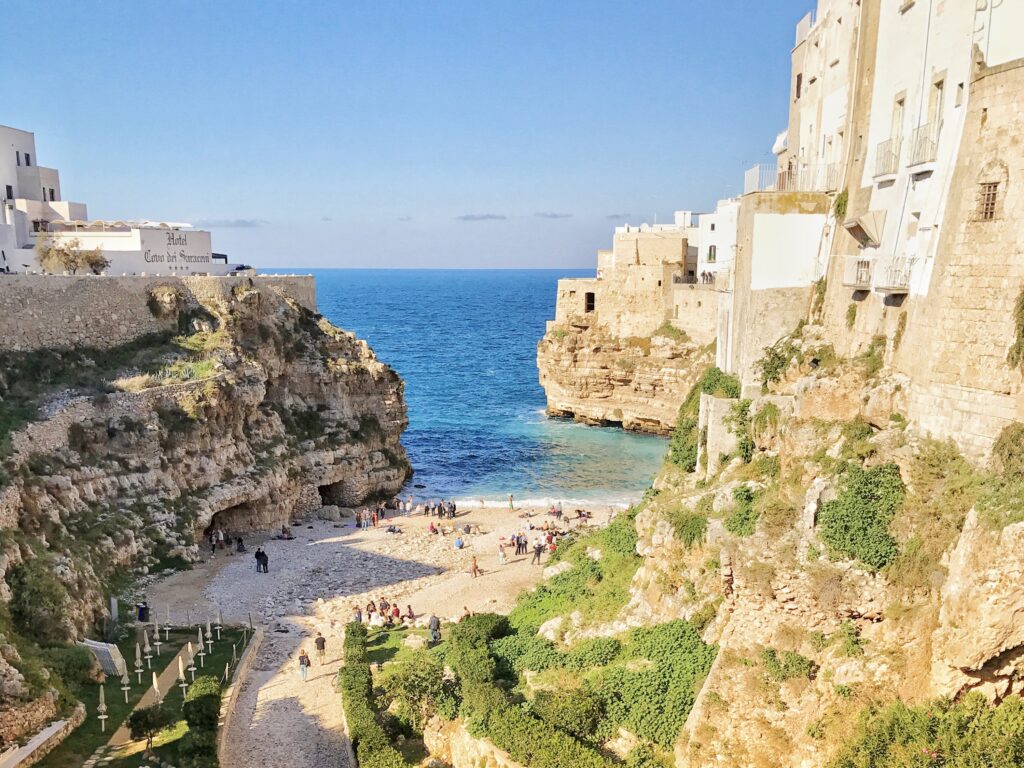
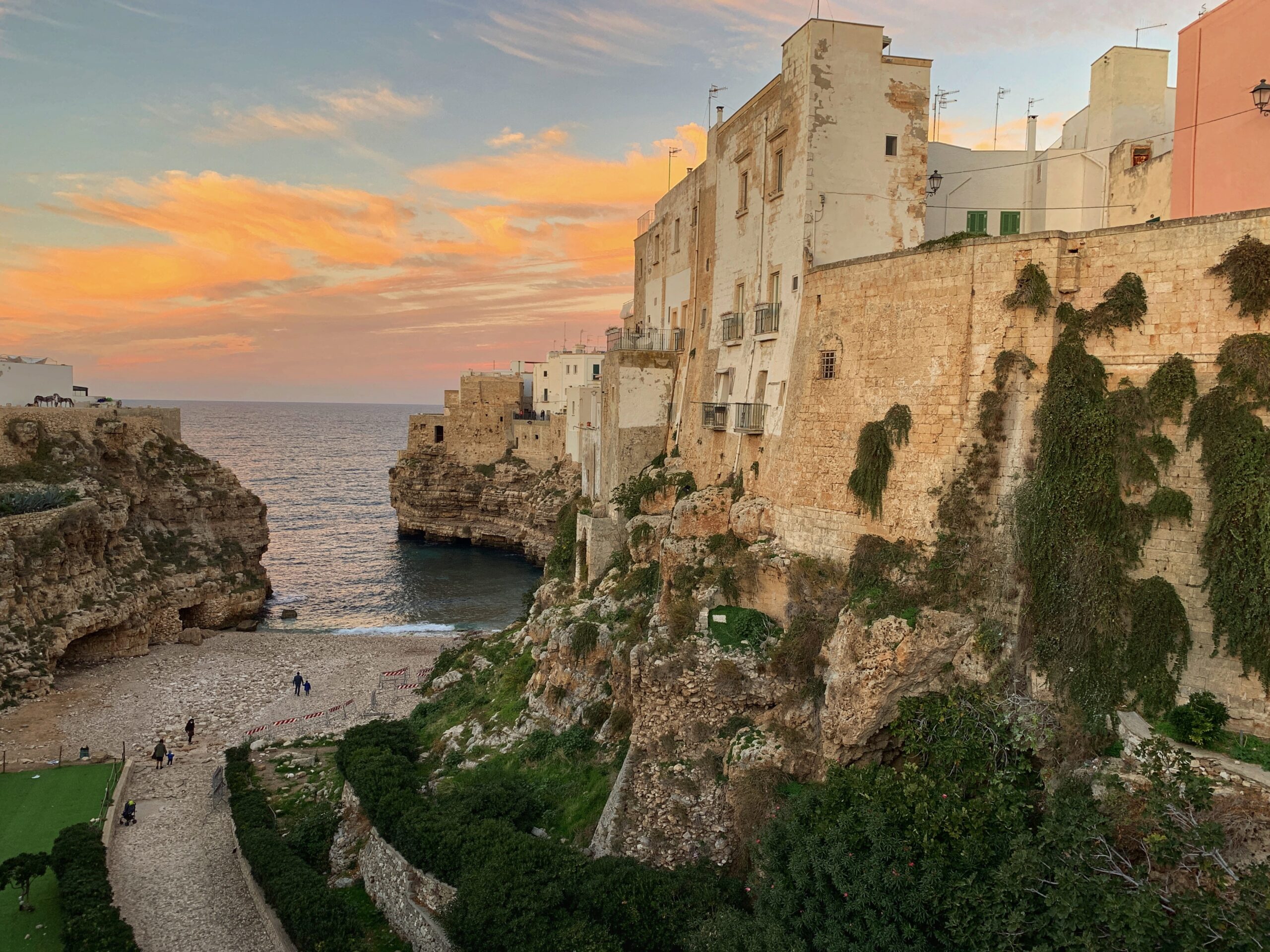
Where to Eat
Our biggest challenge is that there is not enough time of the day to fit in all the food we want to eat. Seafood is of course a speciality, and after its beach and Domenico Modugno, Polignano is also famed for its outstanding ice cream.
Pescaria | Piazza Aldo Moro, 6/8 | +39 080 4247600 | epic raw, fried and cooked street food, as the queue that regularly forms outside suggests | famous for its fried octopus panini with cime, garlic and oil, fig syrup, ricotta and pepper and anchovy oil | or try the red shrimp tartare panini with buffalo mozzarella, passion fruit mayo, spinach salad with oil and lemon, Murgina apple, chopped pistachios and Polignano carrot chips | pescaria.it | €-€€
Mint Cucina Fresca | Piazza San Benedetto, 32 | +39 080 4241373 | small and intimate for a romantic dinner | try the fish burger with caramelised pineapple, sprouts, purple potatoes and Polignano carrot spaghetti | closed on Sunday and Monday nights and from the end of October to 21 March | Mint Cucina Fresca | €€-€€€
Casa Mia Trattoria and Pizzeria | Piazza Garibaldi, 38/40 | +39 080 3325161 | info@casamiapolignano.com | traditional trattoria with a modern twist | wood fired pizza oven | home cooking using fresh locally sourced ingredients | we enjoyed our visit, but reviews can be mixed as to service and attitude - you are not likely to be welcome if you order one pizza to share | Casa Mia | €€-€€€
Mario Campanella “Il Super Mago del Gelo” | Piazza Garibaldi, 22 | +39 080 4240025 | gelateria | serving up ice cream since 1935 | photographs of celebrity patrons adorn the walls | try their speciality coffees | website | €
A Warning to the Curious | Grotta Palazzese
Located in the cliff with terraces overlooking the Adriatic is the visually impressive Grotta Palazzese. While it has undisputed spectacular views, it is the location rather than the quality of the food that diners pay for. For us it represents poor value for money. Our team have eaten there twice, in 2020 and again in 2024, before and since new management. On both occasions the food was extremely disappointing and ultra expensive by local standards. We regularly eat much better elsewhere, and for far less. We hesitate to describe anything as a “tourist trap”, but on this occasion nothing less seems appropriate.
In 2019, under the previous management,Grotta Palazzese received the maximum fine for cooking with out of date meat - a month out of date. It was also found to be using sea bass steaks and fillets, king crab legs, pasta and frozen cuts of meat all without documentation tracing their legitimacy.
Do your own due diligence and read reviews. Based on reviews, most diners seem to leave disappointed, with the same experience of an “overpriced bill, disappointing food”.
If you choose to go, book in advance and be prepared for a menu whose pricing is even more breathtaking than its views. If travelling by car you can park on the city outskirts and they will send private transport to collect you and return you.
Note: In March 2025 Grotta Palazzese will re-open under chef Martino Ruggieri, originally from Martina Franca and recently returned from Paris where, in under two years he obtained two Michelin Stars with his Maison Ruggieri. The Polignano cave restaurant will be one four restaurants that he will manage under the Grotta Palazzese brand. We can only hope that the new iteration will improve on its thus far aspirational style over substance!
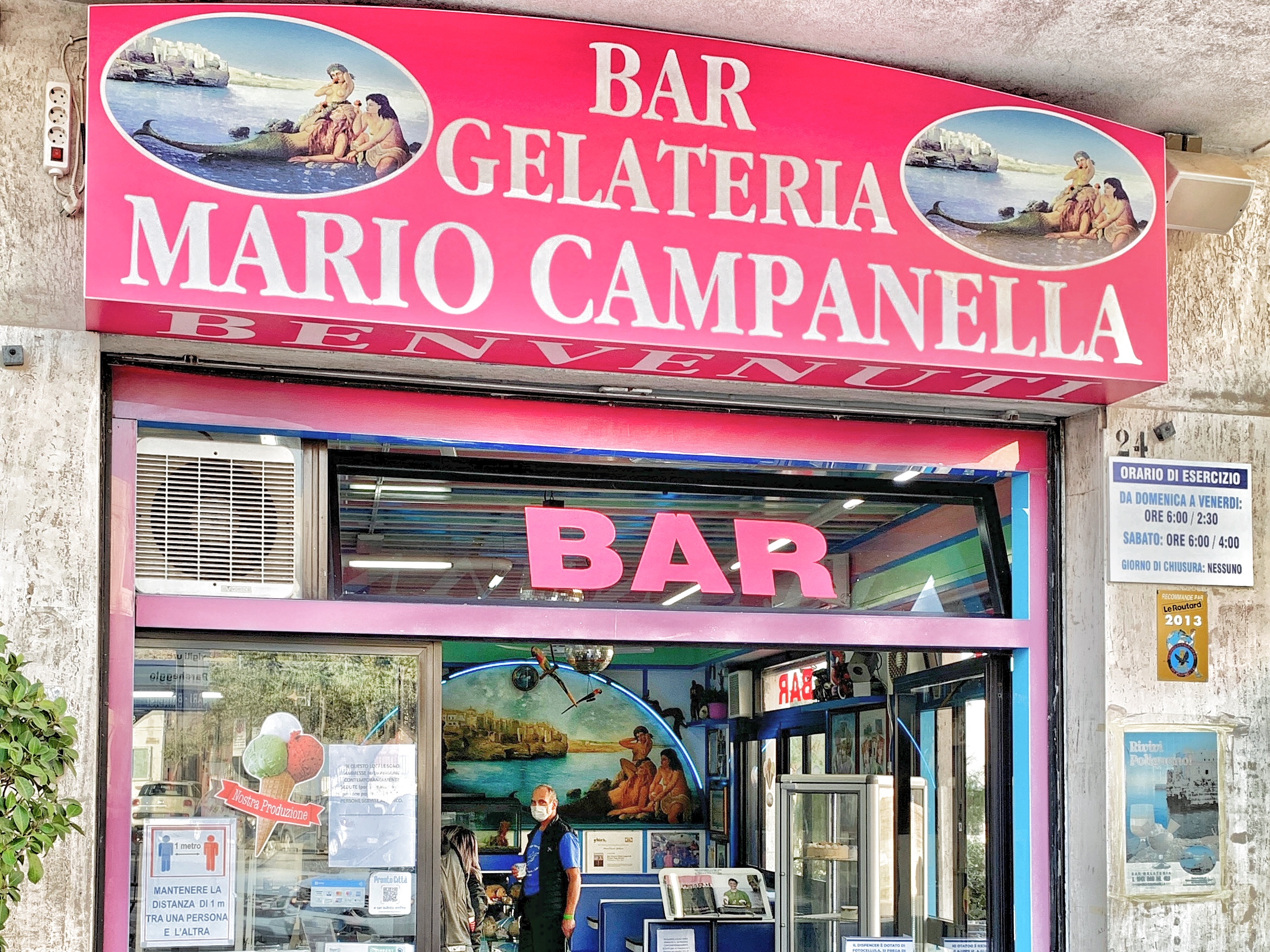
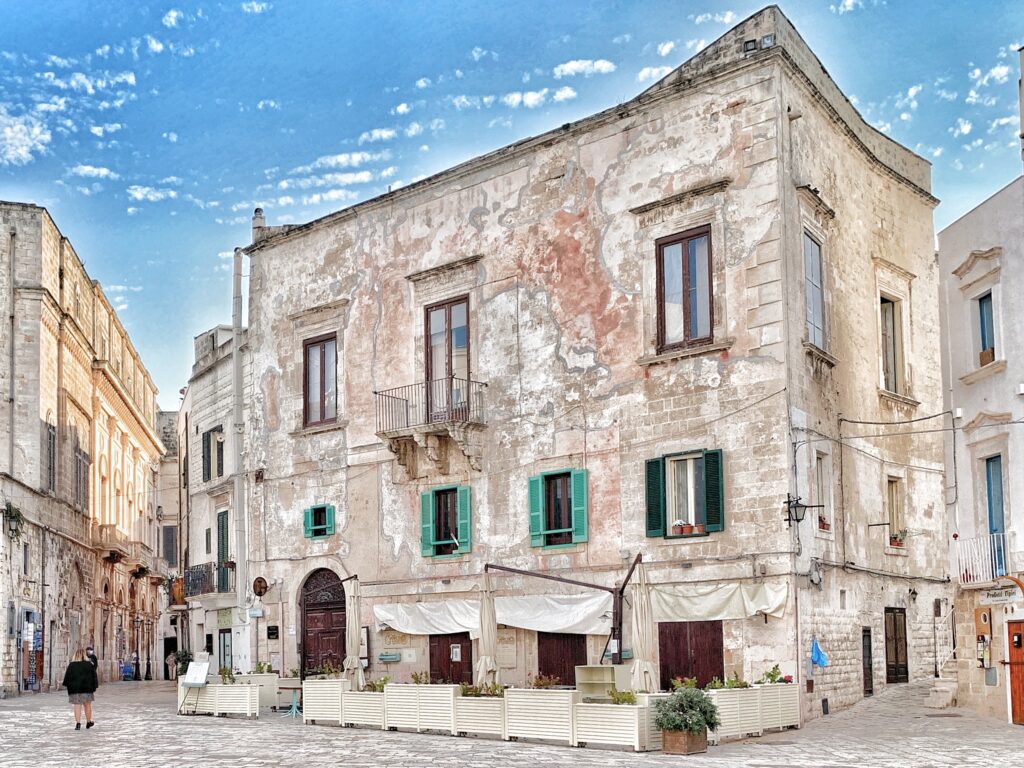
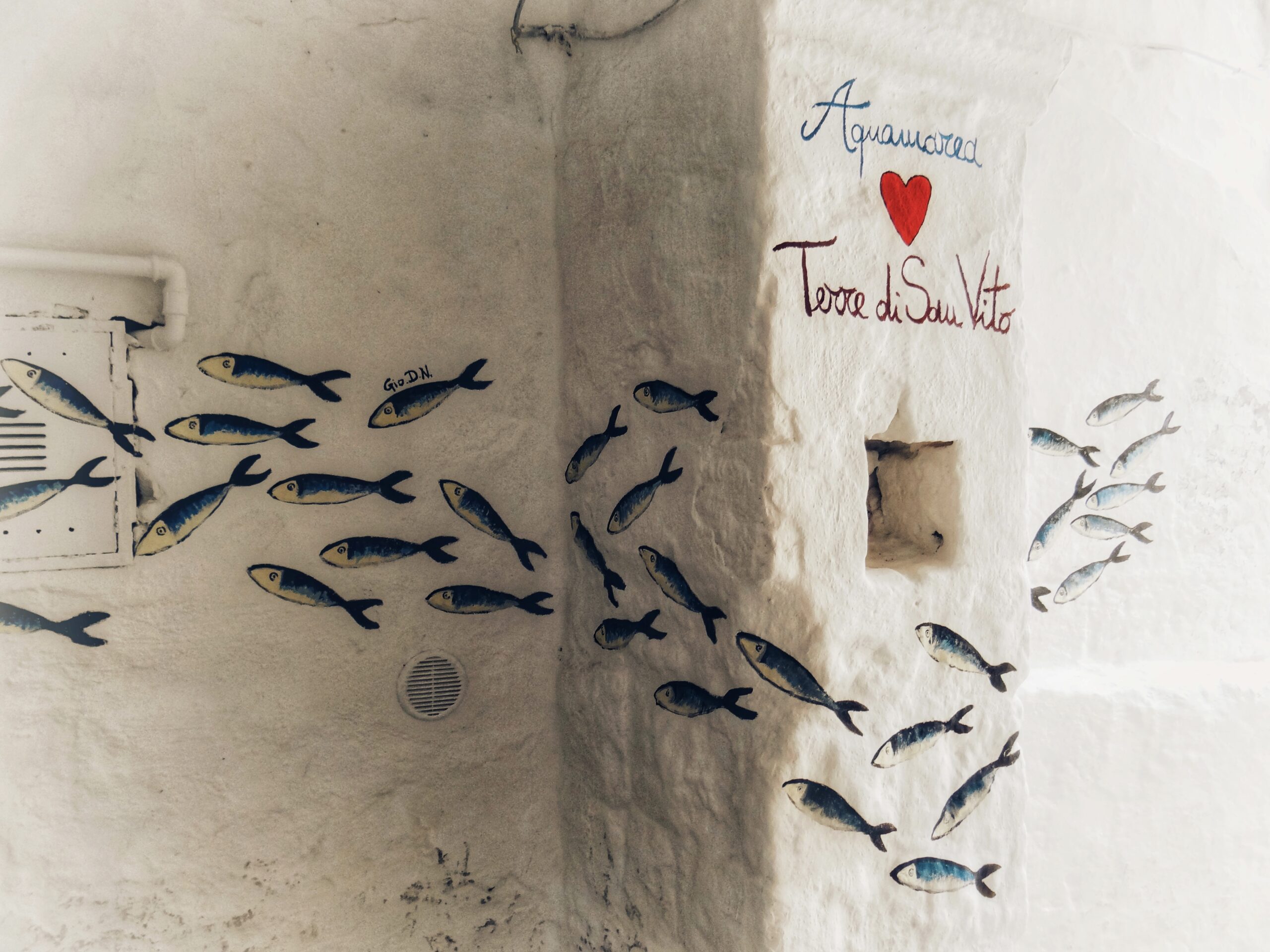
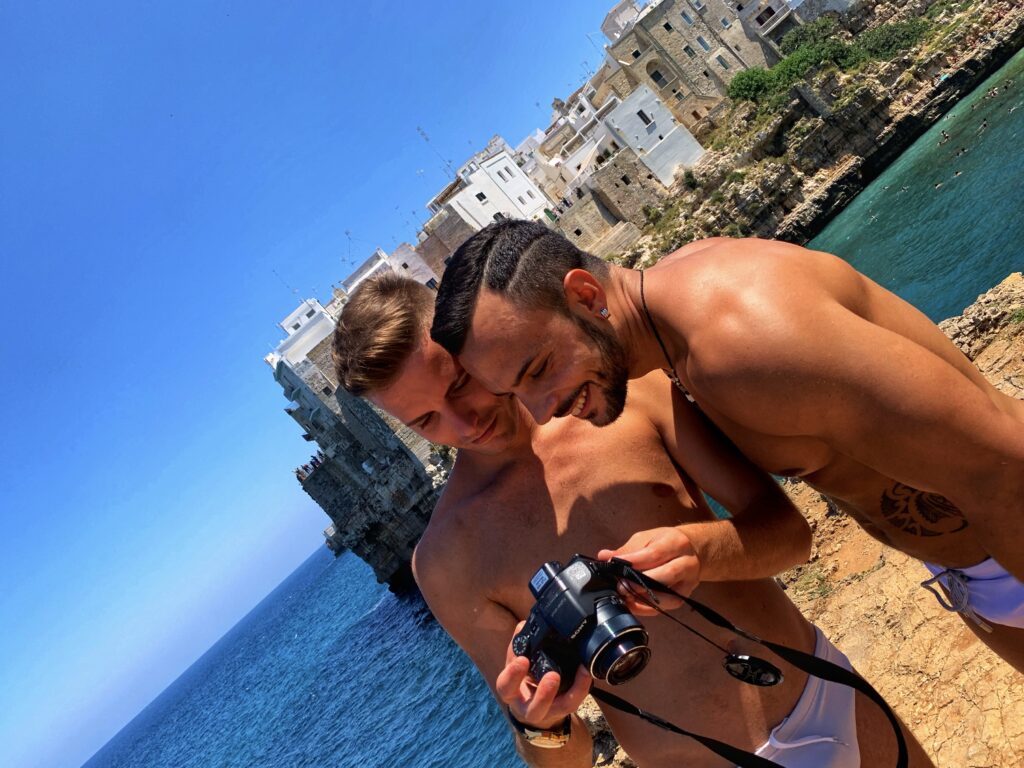
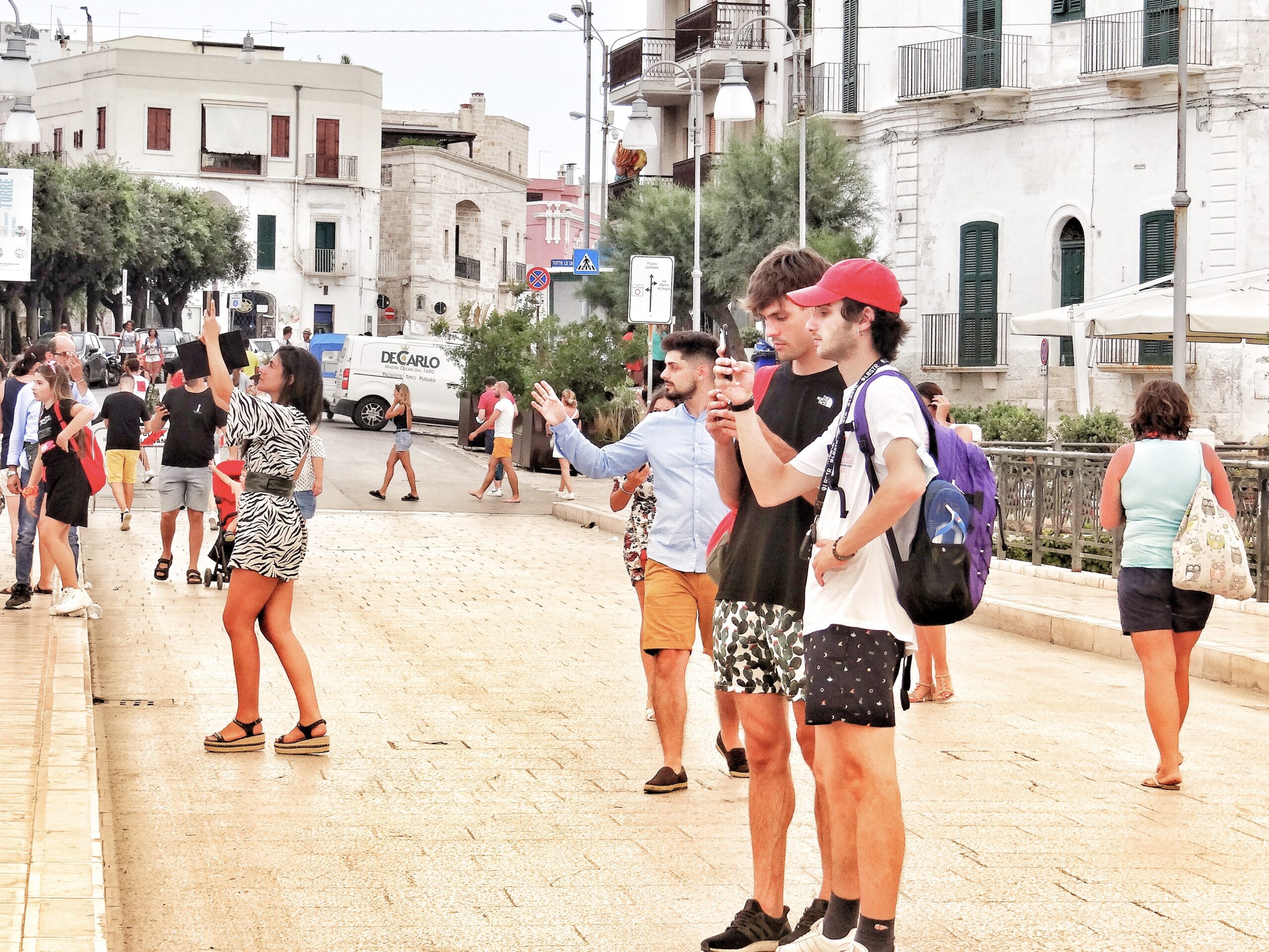
What To do
Caffé speciale and gelato | Polignano a Mare is also known as ‘la città del gelato’ - the town of ice cream | another speciality is the caffé speciale invented by Mario Campanella, made from espresso coffee, sugar, cream, lemon zest, and Amaretto liqueur.
Lama Monachile and the Roman Bridge | the best place to experience Polignano’s stunning coastline | access via the stone steps behind the bridge or from the ramp leading from Via Conversano | there are no facilities on the beach though it is located in the city centre.
Museum of Contemporary Art - Pino Pascali | Via Parco del Lauro, 119 | +39 080 4249534 | +39 333 2091920 | Puglia’s only permanent contemporary art museum holds temporary exhibitions alongside its permanent exhibition | Museo Pino Pascali
Promenade along the seafront | promenades run both to the north and south of the centro storico | the best views are from the balcone to the south, the bridge and the spiaggia Domenico Modugno | take the steps down from his statue.
Peppino Campanella Oggetti di Luce | Via Conversano, 9 | +39 335 672 6257 | the most amazing lights and glass houseware in a fascinating workshop/gallery tucked away in a little side street | peppinocampanella.it
Santa Maria Assunta | enjoy artifacts made entirely of stone, such as the famous nativity scene, attributed to the sculptor Stefano da Putignano, who was active between the seventeenth and eighteenth centuries.
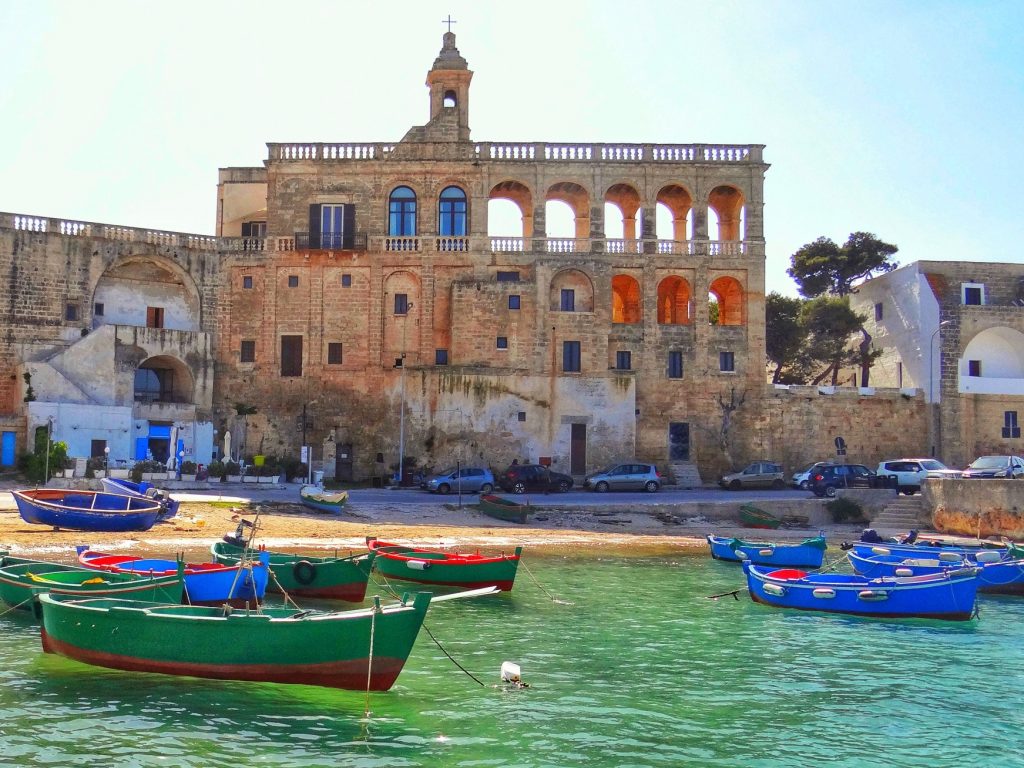
Abbazia di San Vito | the magnificent San Vito Monastery commands a beautiful view overlooking the sea. The hamlet of San Vito is 3.2km north east from Lama Monachile.
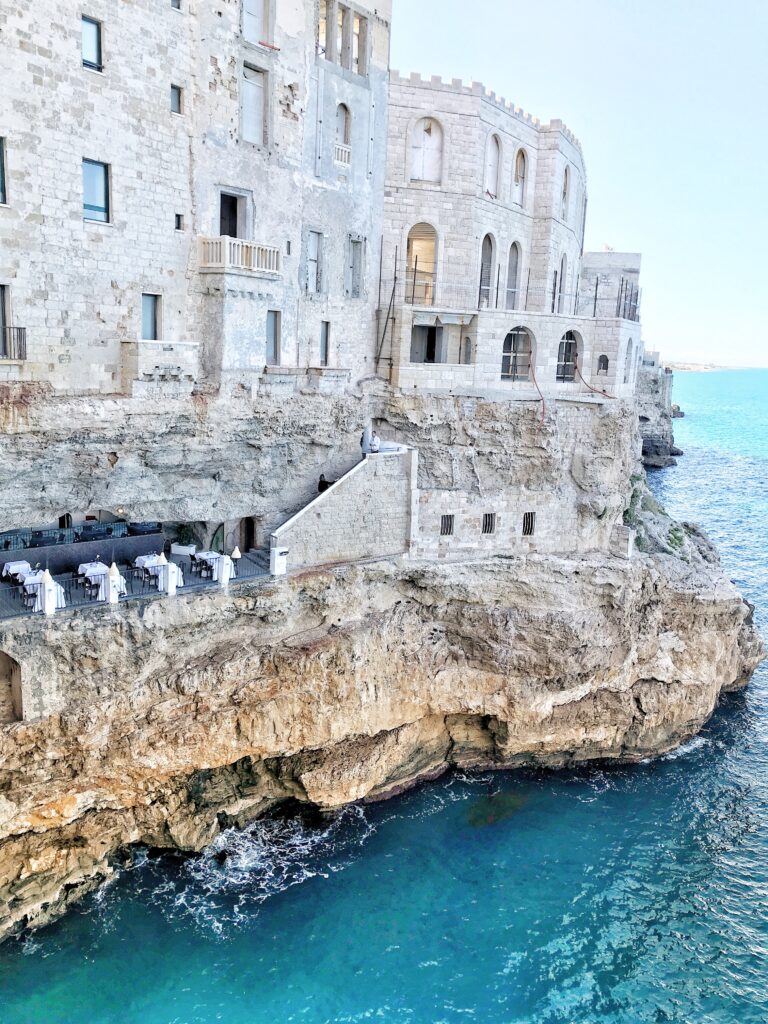
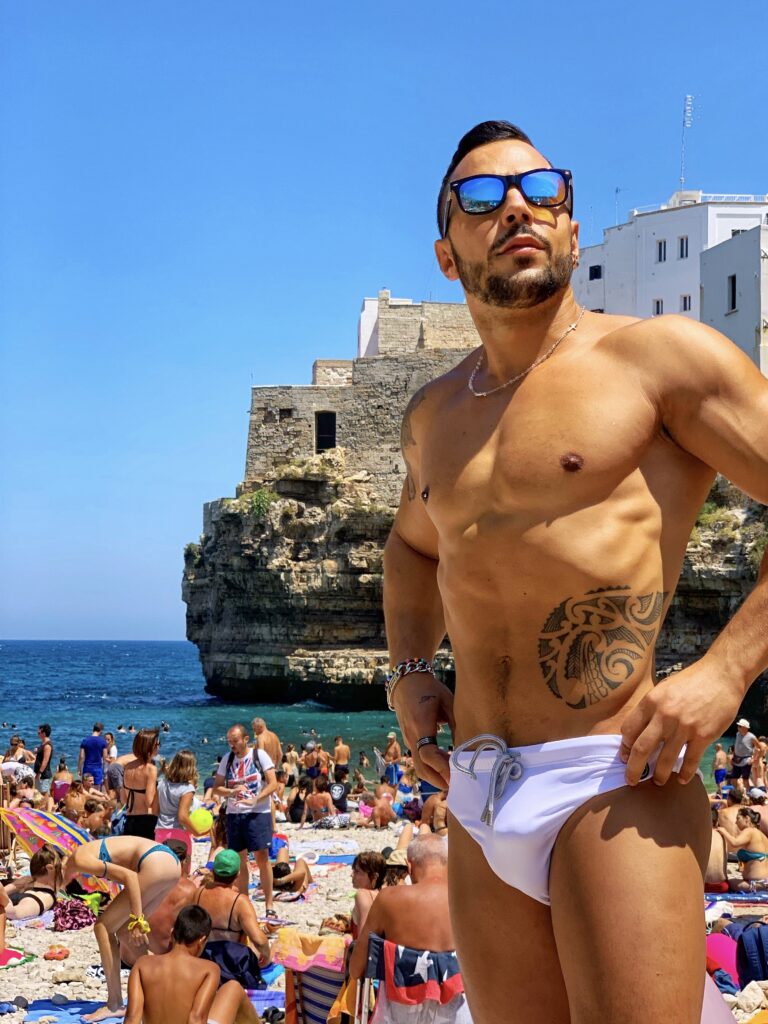
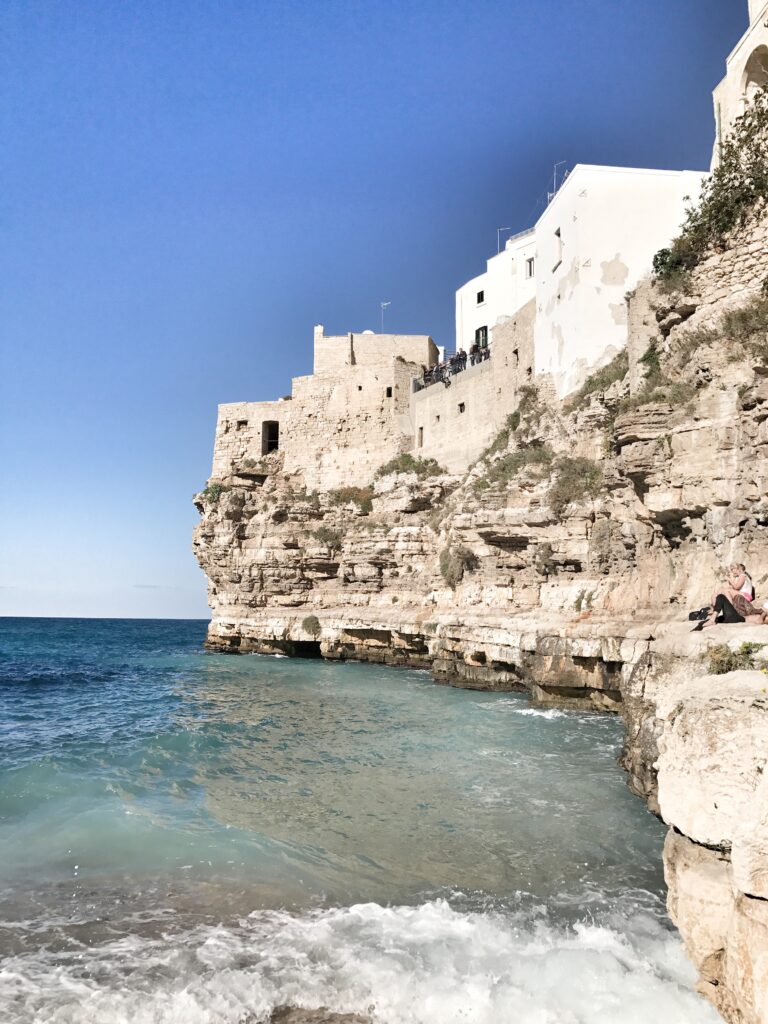
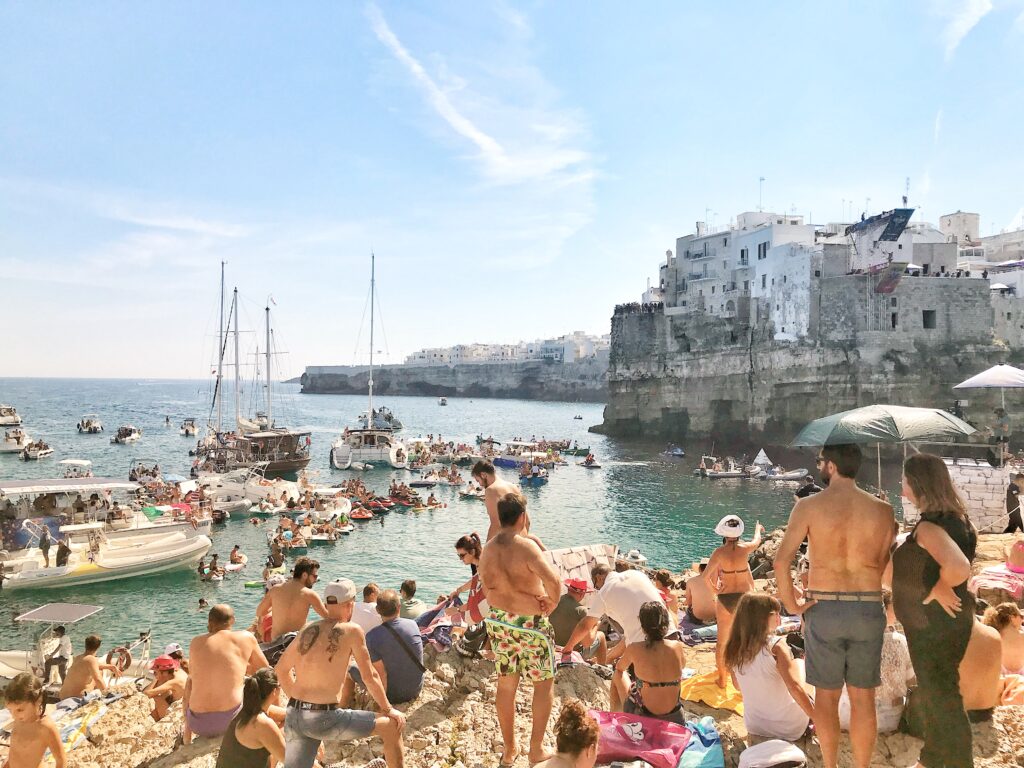
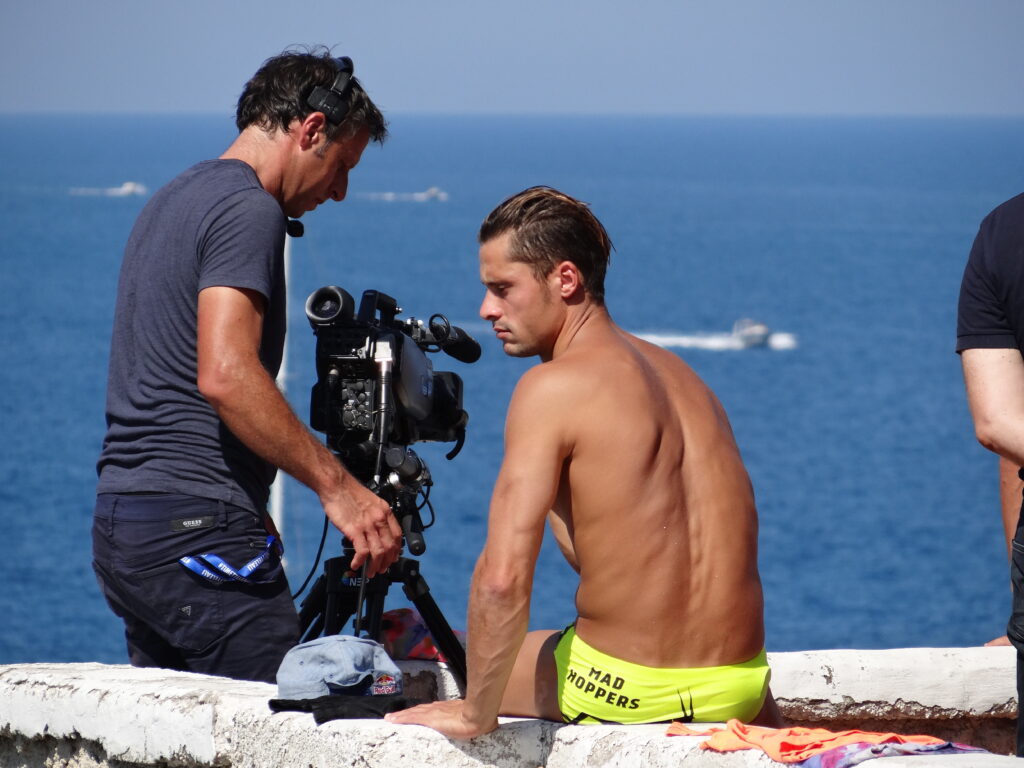
The Red Bull Diving Competition
Since 2009 Polignano a Mare has hosted the Italian round of the Red Bull Cliff Diving World Series an international diving competition.
The competition sees men and women dive from platforms placed at 27 and 21 meters above the sea level.
Volare
Find the statue of Domenico Modugno the Italian singer who co-wrote and originally performed Volare; the most famous song never to have won the Eurovision Song Contest and the most-played Italian song in the world.
Modugno was born in Polignano a Mare, and the locals are extremely proud of their famous citizen. The statue shows Modugno singing in his famous Volare pose - arms outstretched, face to the skies.
The song came third in the 1958 contest.
In 2005 Nel blu, dipinto di blu was ranked second on the list of the "all time favourite songs of the Eurovision Song Contest," behind ABBA's "Waterloo". ABBA's former member Benny Andersson commented that he himself had voted for it.
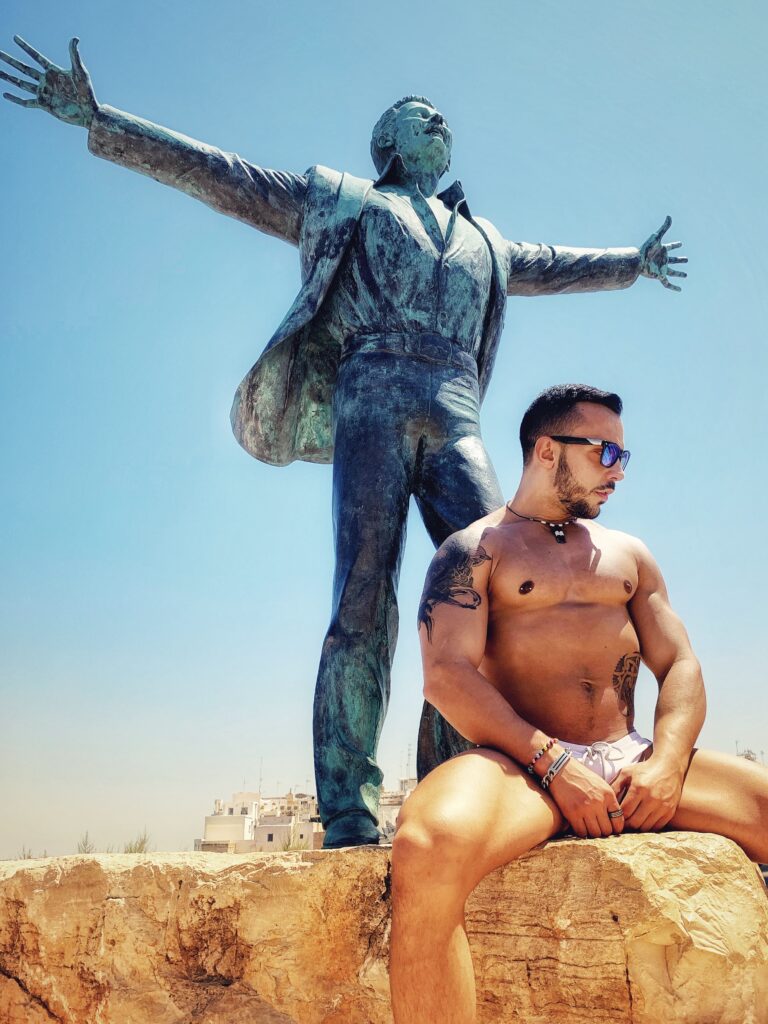

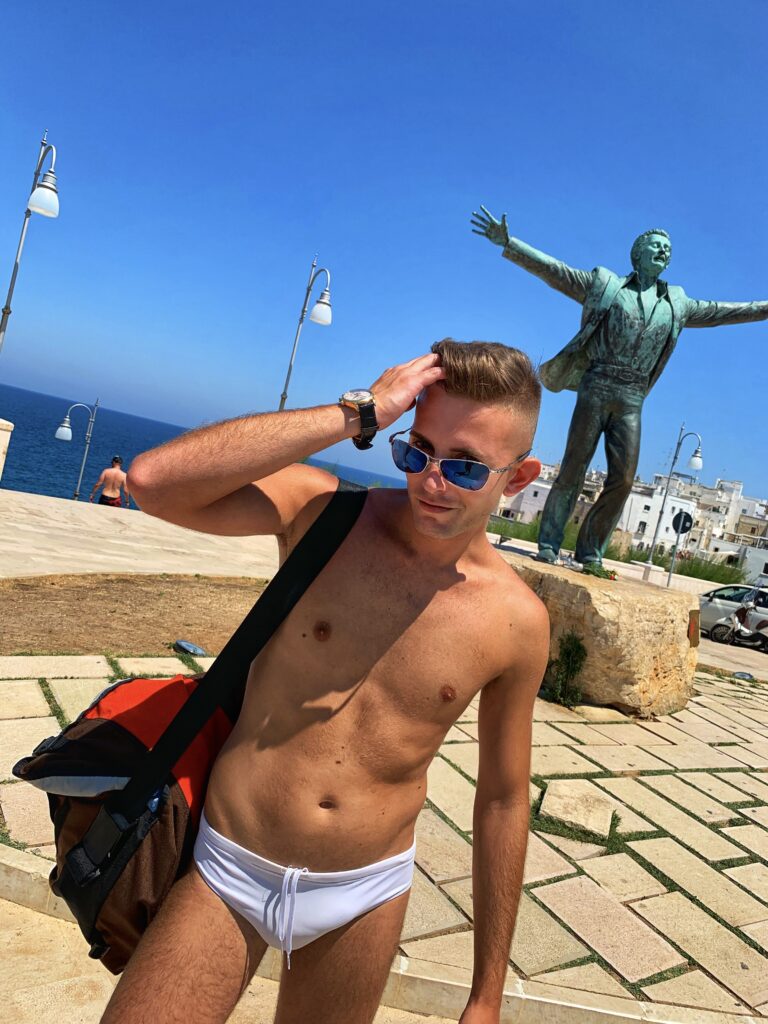
Getting there
Polignano a Mare sits on the main Bari - Lecce train line. From Bari it’s around 25 minutes, and usually cheaper than the bus.
By car from Bari | north - exit the SS16 at the Polignano a Mare Nord junction | south - exit at the Polignano a Mare Sud junction | stay on the road, it will take you right to the centre of Polignano.
We usually drive down to Piazza Aldo Moro and park in the streets around there. If not, you can drive up to the train station and park around there - it’s less than a 10 minute walk back to the piazza and about 300 meters more to Lama Monachile. Otherwise turn off in the direction of the sea and try around Piazza Trinita.
Check out the parking section in our Big Driving in Puglia FAQ for information on free | pay parking spaces.
Want some more?
Why not try the much less visited Santa Cesarea Terme. Geologically as impressive, with hot water baths and some spectacular outdoor swimming spots. South of Otranto, about 35 km (21 miles) from Lecce, Santa Cesarea Terme overlooks the Adriatic atop a plateau that plummets dramatically into the sea.
La Cena di Natale | by Marco Ponti
A 2016 comedy set in Polignano a Mare, but with Monopoli doubling in many of the exterior scenes. With Riccardo Scamarcio.
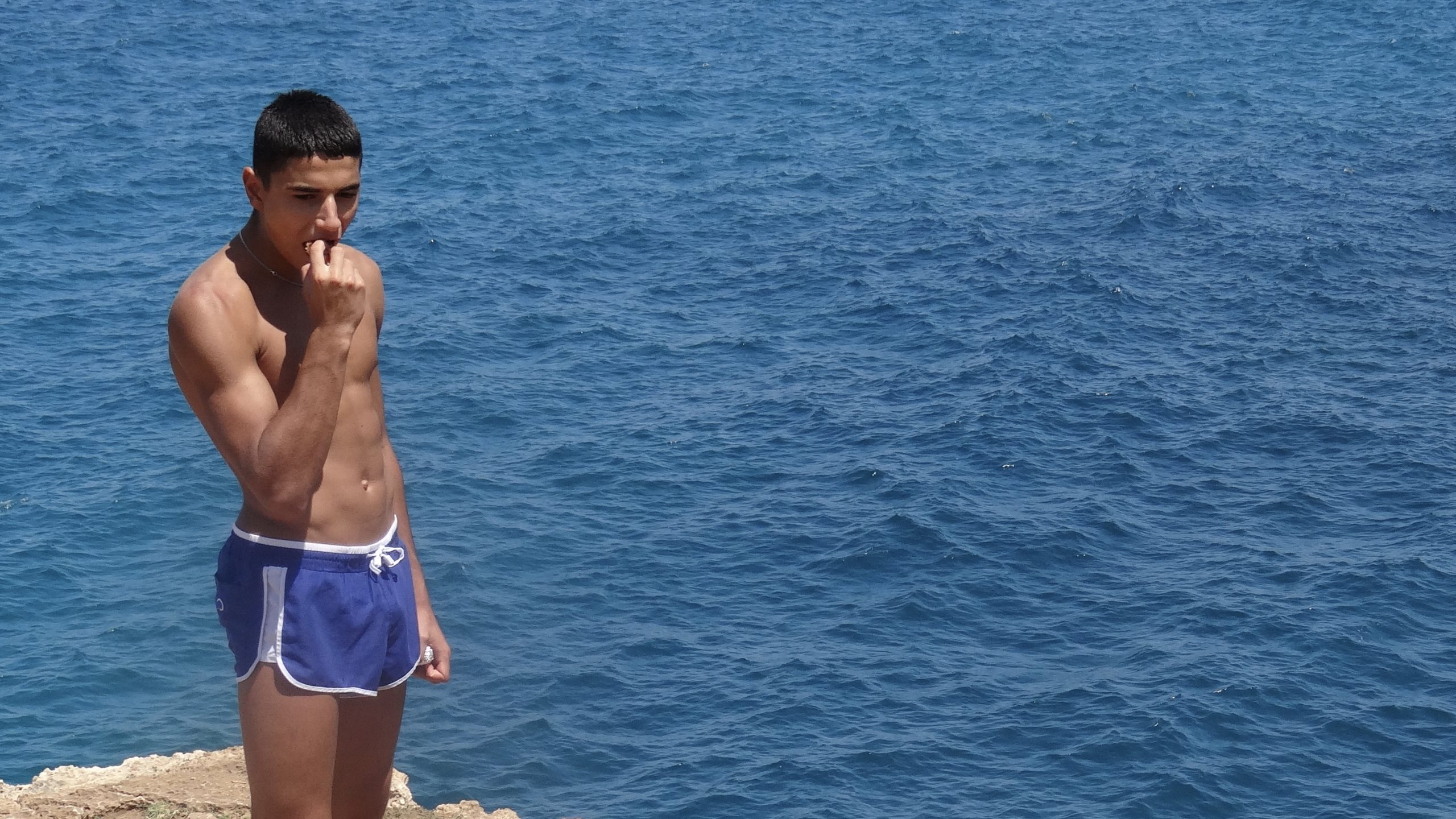
Where’s the sand?
Try Torre Guaceto, about 40 minutes south.
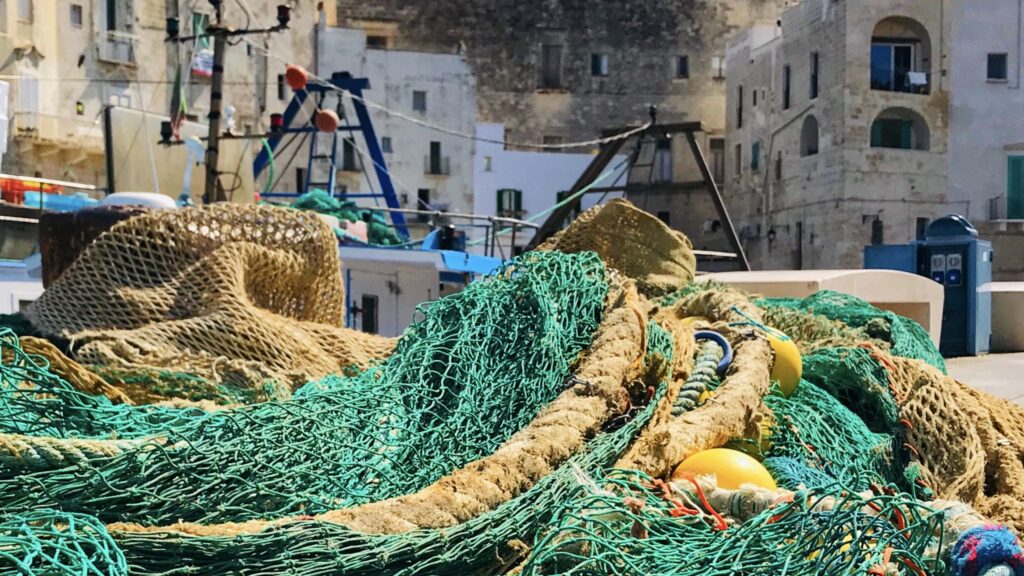
Monopoli
Polignano’s near neighbour is just a short hop. Read our Monopoli guide.
